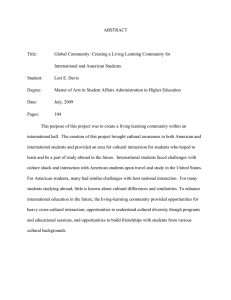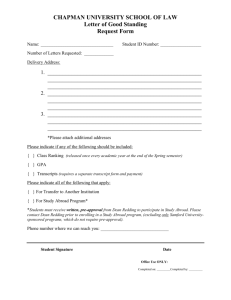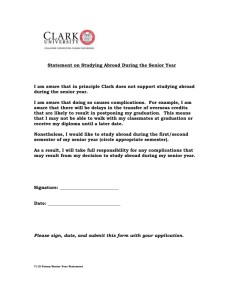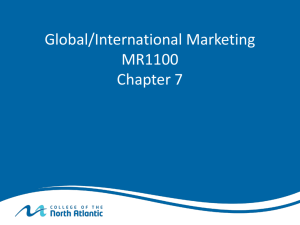Senate Minutes February 20, 2006
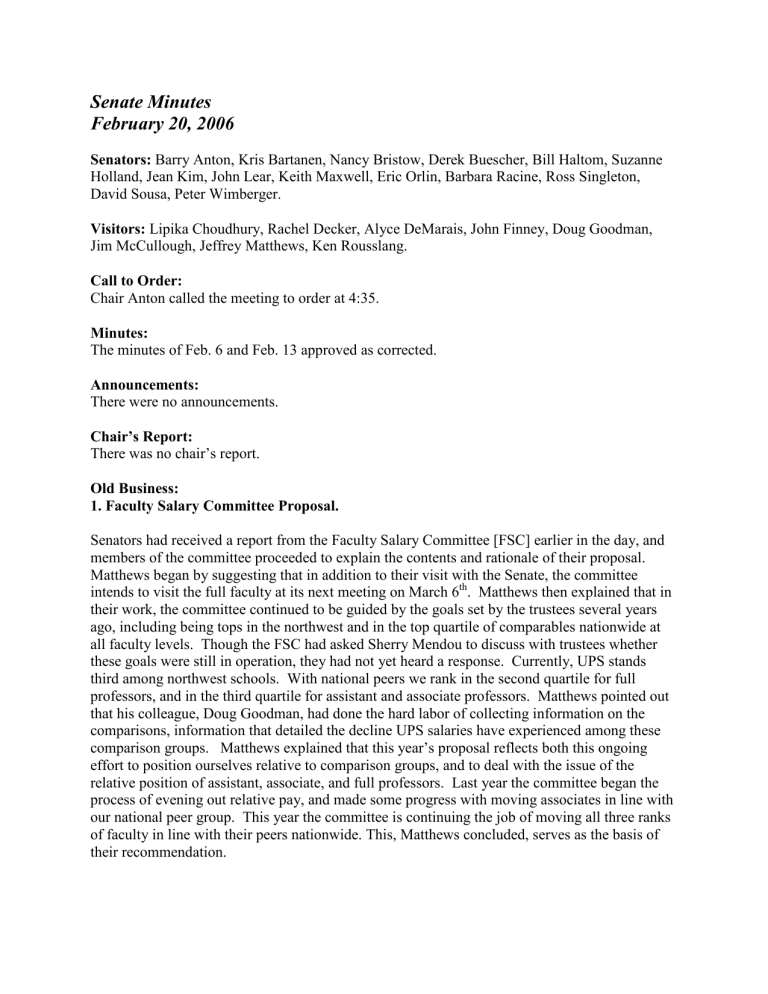
Senate Minutes
February 20, 2006
Senators: Barry Anton, Kris Bartanen, Nancy Bristow, Derek Buescher, Bill Haltom, Suzanne
Holland, Jean Kim, John Lear, Keith Maxwell, Eric Orlin, Barbara Racine, Ross Singleton,
David Sousa, Peter Wimberger.
Visitors: Lipika Choudhury, Rachel Decker, Alyce DeMarais, John Finney, Doug Goodman,
Jim McCullough, Jeffrey Matthews, Ken Rousslang.
Call to Order:
Chair Anton called the meeting to order at 4:35.
Minutes:
The minutes of Feb. 6 and Feb. 13 approved as corrected.
Announcements:
There were no announcements.
Chair’s Report:
There was no chair’s report.
Old Business:
1. Faculty Salary Committee Proposal.
Senators had received a report from the Faculty Salary Committee [FSC] earlier in the day, and members of the committee proceeded to explain the contents and rationale of their proposal.
Matthews began by suggesting that in addition to their visit with the Senate, the committee intends to visit the full faculty at its next meeting on March 6 th
. Matthews then explained that in their work, the committee continued to be guided by the goals set by the trustees several years ago, including being tops in the northwest and in the top quartile of comparables nationwide at all faculty levels. Though the FSC had asked Sherry Mendou to discuss with trustees whether these goals were still in operation, they had not yet heard a response. Currently, UPS stands third among northwest schools. With national peers we rank in the second quartile for full professors, and in the third quartile for assistant and associate professors. Matthews pointed out that his colleague, Doug Goodman, had done the hard labor of collecting information on the comparisons, information that detailed the decline UPS salaries have experienced among these comparison groups. Matthews explained that this year’s proposal reflects both this ongoing effort to position ourselves relative to comparison groups, and to deal with the issue of the relative position of assistant, associate, and full professors. Last year the committee began the process of evening out relative pay, and made some progress with moving associates in line with our national peer group. This year the committee is continuing the job of moving all three ranks of faculty in line with their peers nationwide. This, Matthews concluded, serves as the basis of their recommendation.
Singleton asked if the committee had heard back from the trustees. Bartanen interjected with context on the source of the original salary goals, changes in the comparison groups, and some recent information from discussions with the Academic and Student Affairs Committee of the board. The original goals—to be at the top of our northwest comparison group and the top quartile of our national peers—were based on the work of the Committee on the ‘90s. Bartanen reminded the Senate that we have changed our comparison group since then, and so though our relative position has slipped, this reflects in part the fact that we have joined a group of comparison institutions with larger endowments. We are in the middle of this comparison group.
Wimberger asked when the comparison group had changed. Bartanen suggested it may have been about five years ago. Goodman mentioned that the “new comparison group” is not entirely new, citing overlap between the old and new groups. Bartanen noted that UPS is eleventh among the twenty in our comparison peer group, but eighteenth in terms of endowment per faculty member. She added that the trustees did not articulate a particular goal at this point, because they want to see further analysis before committing to a goal.
Matthews suggested that the committee had tried to be straightforward, and led senators through the chart that reflects their proposal. Sousa, with an interest in the university’s ability to hire the best candidates, asked Bartanen whether it is her sense that UPS is highly competitive at the level of new hires, and whether the ratio problem is more important than the third-quartile ranking for assistant professors. Bartanen explained that she continues to worry about salaries and their role in recruitment. UPS used to run above others, but now is on same level as our national peers. Put simply, we are losing ground. However, she noted that UPS has been lucky with its pools of candidates the last few years, and added that location has worked well for us.
But there is continuing pressure at the beginning salary level. Bartanen reiterated that we need to continue to keep this issue in mind, and suggested that last year’s decision to deal with only part of the parity issue stemmed from this concern.
Matthews returned to the issue of full professors, and the problem of asking senior faculty to take such low raises. He found that the logic bothered him, as he asked senior colleagues to take what seemed like a relative pay cut. Bartanen suggested that while she understands that point, she also notes that dollar amounts are different from percentages, so while a junior person’s raise may be of a larger percentage, the dollar amount is still smaller than that of a senior colleague. This is even truer for those who are getting a step increase as a full professor. Holland expressed concern about the percentages for full professors relative to the rate of inflation, and found this unjust. Rousslang maintained that in terms of attracting junior faculty, teaching load is a more significant issue than compensation. Bristow maintained that as a full professor, she doesn’t mind receiving a smaller increase, given that she is still being paid so much more than others who work just as hard, give just as much, but are paid smaller salaries. Wimberger reminded the
Senate that this dynamic was evident earlier in the 1990s as well. In that case, the decision was to go with the same increase across the boards. He expressed his belief that anything we can do to remain competitive in attracting good colleagues is really important. Lear asked if there were no junior faculty represented on the committee. Matthews noted that he has been junior until a few days ago. As a new member of the committee, he saw a problem with senior faculty taking what seemed like a pay cut relative to other faculty. In this context, the rationale of setting the ratio objective made sense to him.
Singleton asked Bartanen if she was recommending that we wait to see more data regarding the index between levels in order to see how the mix has changed in the interim. In other words, do we need more data in order to know where we stand? Bartanen explained that the Budget Task
Force talked with the FSC, and felt good about their recommendations for salaries, but recommended waiting until more complete data was available before making any alterations in the index. She is not expecting huge changes, but also noted that there might be a relative change for full professors, and so it makes sense to wait before altering our goals. Goodman agreed that these things vary, but reminded the senate the national peer figure is averaged over the last ten years, not just last year, and so one year will make some difference, but it will be influencing a larger set of data.
The Senate thanked the members of the FSC for explaining their recommendations, and for all of their hard work.
2. New Study Abroad Categories and Related Transcripting Procedures.
Three members of the Study Abroad Committee (ISAC), Senators Singleton, Wimberger and
Lear, were in attendance. Singleton began the presentation, noting the committee’s intention, unless the Senate directed otherwise, was to submit their recommendations to the appropriate committees as their charge directed them. Associate Dean DeMarais mentioned that the
Curriculum Committee had already approved the recommendations for the new categories for study abroad programs. Singleton reminded senators that the last time the ISAC had appeared they had outlined their efforts to refine the distinction among our study abroad program categories so that students, parents and faculty could better understand the structure of the Study
Abroad committee, why we have the different categories of programs, and the advantages and differences between them. Singleton reiterated that the Curriculum Committee has approved the new program categories. As part of the development of the new categories, the committee also began considering how study abroad is reflected on UPS transcripts. Singleton distributed a handout with new data, collected as a follow-up to the meeting on 21 November 2005. At that meeting Singleton, Lear and Wimberger had offered their proposal for a change in how study abroad courses appear on transcripts. Specifically, they suggested that students who study on what are now called “partner programs” would have those credits appear on the UPS transcript, with titles for the courses and grades, though the grades would not be computed into the UPS
GPA. The reasons for this proposal were reiterated in the statement distributed by Study Abroad
Committee. The committee hopes to clarify the nature of what used to be called “affiliated programs” and will now be called “partner programs” as programs that are more closely linked to the institution than “approved programs.” These partner programs are special in the view of the ISAC. These are based in well developed relationships, students pay UPS tuition, students receive UPS financial aid and residency credit, and students are vetted by the UPS selection committee. None of these factors are true for the approved programs, and these are significant differences. Singleton reminded the Senate that they had brought this idea forward on November
21, at which time Dean Finney had suggested that the partner programs were created due to federal requirements having to do with loans. Singleton explained that the ISAC disagrees, maintaining instead that the partner programs were created consciously by the university because the structure benefits the institution and the student. Also, Singleton pointed the Senate to the research completed by members of the ISAC, which offered substantial evidence to suggest that
some of those with whom we often compare ourselves may do something like what the ISAC has proposed.
Wimberger then described the new data collected by the ISAC since November. In particular, they had obtained a more detailed data set from IES involving a survey of 128 schools.
Questions asked in the survey included, “Do you charge institutional tuition for IES program courses? Do you list IES study abroad courses on your transcripts? Do you list IES grades on your transcripts?” The data showed that of the 128 schools, twenty of them charge school tuition for IES programs, including UPS. Of those 20, 18 list study abroad courses on their transcripts,
13 list study abroad grades, and 8 include those grades in their GPA. Of the twenty schools that charge school tuition, only two schools don’t list courses on the transcripts—UPS and MIT.
Among schools that list courses and grades are Connecticut College, Knox, Occidental, Pomona,
Carleton, Scripps and Willamette. Wimberger maintained that UPS is in good company. He also noted that Janie Meisberger had surveyed northwest schools—Whitman, Reed, Lewis and
Clark, Willamette, PLU Gonzaga and University of Portland— to find out about their practices.
Wimberger noted that all of those surveyed list courses and grades for affiliated (partner) programs on their transcripts, the ISAC’s proposal. Wimberger also expressed concern that sometimes our students run into problems getting their transcripts from study abroad programs for employers or graduate school applications. In this context, listing the courses and grades would be a service to our students.
Anton opened the floor for discussion, and turned to Finney to allow him the opportunity to make a statement. Finney suggested that he had said his piece earlier, and distributed a copy of the notes from which he had spoken during his previous presentation in November. Finney also suggested that one of the things Wimberger had said, that consumers of records would accept our version of the grades rather than insisting on going to the original source for grades, worried him greatly. He also suggested that if he had time, he would investigate what other schools are doing, suggesting he is confident that they are not listing study abroad grades on their transcripts.
He suggested that what is probably happening is that schools are coming up with their own read on what courses will do for their own degree programs, and listing some variation of that on their transcripts. This is probably a far cry from what students originally took while abroad. He maintained his conviction that what is being inferred from the surveys is not what is actually going on, and suggested further that whatever we do to give consumers of records the idea that they don’t need to pursue the acquisition of original records is the wrong thing to do, because records fraud is a major issue in this society. This is something he believes we should not contribute to. If we list study abroad grades on our transcripts, Finney explained, we would be making a claim that we cannot testify to, because we did not award those credits. He wondered if this is this only about how we package information.
Orlin suggested that he liked what the ISAC has brought forward, and described a recent experience with a student in which he had sought out study abroad information online and had not been able to access it. Also, he noted that the partner programs have a different status because we, as an institution, have evaluated those programs and determined their credibility.
Orlin suggested that he likes the compromise offered by the ISAC—listing the grades but not including them in the GPA. Bartanen articulated that Finney may have been suggesting that we could help advisors better, without having to go this route. Wimberger returned to the issue of
the comparison to transfer credits, and suggested it is not a relevant comparison because students pay UPS tuition for study abroad but not for transfer credit, and also receive UPS residency credit for study abroad with partner programs. These courses, he argued, are the equivalent of spending time at UPS. He also made two other points, first suggesting that he thought that of the northwest schools, only one does the kind of conversion described by Finney. Other schools list the courses as IES courses. Wimberger also suggested that having study abroad grades on the transcript might serve as motivation for students’ academic performance while abroad.
Hanson asked Finney about the possibility of a compromise, perhaps using a transcript addendum. Finney was more comfortable with this kind of approach, and suggested that what he objects to is giving anyone the idea that we are sanctioning these credits. He also noted that everything that an advisor needs is available already through the transfer evaluator report.
Wimberger said that in his recollection, the transfer evaluator report did not include a grade, while Finney thought that it did. Lear suggested that for him, one of the most appealing aspects of this proposal is that students would have some sense that what they do abroad will show up somewhere. His experience with the Grenada program suggested that it mattered whether students felt their grades had some meaning. Hanson returned to his earlier suggestion, asking for others’ responses. Wimberger believed that an addendum was not necessary, because the study abroad grades would be set off on the transcript itself. Orlin wondered if it would be possible to insert the information in the appropriate chronological space on the transcript, though it should be set off clearly. Finney noted that currently the transcript reflects a study abroad leave of absence, with additional information about where a student studied posted in the upper left corner of the transcript.
Following a brief discussion on how to proceed, the Senate M/S/P a motion to receive the report of the Study Abroad Committee.
Adjournment.
The motion to adjourn passed unanimously at 5:50.
Respectfully submitted,
Nancy K. Bristow
